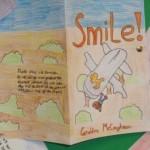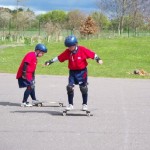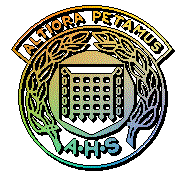

Glow Scotland blog
 The “Which Writer Wins?” initiative takes place each year in Angus and involves around 1200 pupils in 55 primary schools.
The “Which Writer Wins?” initiative takes place each year in Angus and involves around 1200 pupils in 55 primary schools.
P5 pupils are invited to read, or listen to, at least one book by each of three different authors and then to vote for their favourite writer.
This is the third of three cookbooks in which we explore how Glow has added a whole new dimension to this enjoyable and hugely valuable project.
Find out more in the cookbook here
More Ruth Doctor teaches at Northmuir Primary School in Angus. This cookbook looks at how the P5s used a Glow Group to inform other classes about Health Week, to share learning resources they’d created, to display photos of the Health Week activities and to evaluate the project.
Ruth Doctor teaches at Northmuir Primary School in Angus. This cookbook looks at how the P5s used a Glow Group to inform other classes about Health Week, to share learning resources they’d created, to display photos of the Health Week activities and to evaluate the project.
In undertaking Health Week as an enterprise activity, Ruth wanted pupils to take as much responsibility as possible for its organisation – for example, emailing potential activity leaders, speaking to the active schools co-ordinator, drawing up timetables of events and creating folders of work for other classes to get involved in.
Find out more in the Cookbook here
More “We have really taken to using Glow and used it an awful lot over the course of the year in many, many projects. The main impact of this is how much the children’s ICT skills have improved, they are actually seeking out things to do on Glow. One of the most recent projects just now is the children have set up their own Glow pages without any teacher intervention”
“We have really taken to using Glow and used it an awful lot over the course of the year in many, many projects. The main impact of this is how much the children’s ICT skills have improved, they are actually seeking out things to do on Glow. One of the most recent projects just now is the children have set up their own Glow pages without any teacher intervention”
Lauren Budd, teacher, Woodlands Primary School, Carnoustie
Find out more by visiting the Glow Cookbook here
MoreStormy Sunset
Andy Garnett was runner up with his Stormy Sunset in Angus Council’s local competition for an image for Glow light.
Sunset or sundown is the daily disappearance of the Sun below the horizon in the west as a result of Earth’s rotation.
The time of sunset is defined in astronomy as the moment the trailing edge of the Sun’s disk disappears below the horizon in the west. The ray path of light from the setting Sun is highly distorted near the horizon because of atmospheric refraction, making astronomical sunset occur when the Sun’s disk is already about one diameter below the horizon. Sunset is distinct from dusk, which is the moment at which darkness falls, which occurs when the Sun is approximately eighteen degrees below the horizon. The period between the astronomical sunset and dusk is called twilight.
Locations north of the Arctic Circle and south of the Antarctic Circle experience no sunset or sunrise at least one day of the year, when the polar day or the polar night persist continuously for 24 hours.
Sunset creates unique atmospheric conditions such as the often intense orange and red colors of the Sun and the surrounding sky.
Image: Andy Garnett Angus Coucil/Text: Wikipedia.
MoreNarcissus at Blair Atholl
Joanne McFadden was runner up in a competion run by Angus for an image for GLOW light. Her picture of Easter daffodils was captured by her daughter, Rachel, whilst out walking in Blair Atholl.
The ancient Greeks believed the narcissus plant originated from the vain youth, Narcissus. He died after becoming so obsessed with his reflection in a pool he could not leave. The Greeks say that the gods turned his remains into the Narcissus flower. This also led to the daffodil becoming a symbol of unrequited love.
The name Daffodil is derived from ‘Affodell’, a variant of Asphodel.
The Narcissus flower is perceived in the West as a symbol of vanity, in the East as a symbol of wealth and good fortune.
In classical Persian literature, the narcissus is a symbol of beautiful eyes, together with other flowers that equal a beautiful face with a spring garden, like roses for cheeks and violets for shining dark hair.
The daffodil is the national flower of Wales, where it is traditional to wear a daffodil or a leek on Saint David’s Day.
William Wordsworth’s short poem ‘I Wandered Lonely as a Cloud’ has become linked in the popular mind with the daffodils that form its main image.
Various cancer charities around the world, including the American Cancer Society, New Zealand Cancer Society, Cancer Council Australia, and the Irish Cancer Society, use the daffodil as a fundraising symbol. ‘Daffodil Days’, first instituted in Toronto in 1957 by the Canadian Cancer Society, are organized to raise funds by offering the flowers in return for a donation.
Image: Rachel McFadden/Text:Wikipedia
MoreBlack Linn Falls, The Hermitage, Perth and Kinross
This week’s image was taken by Andy Garnett, Active Schools Lead Coordinator, Angus Council and is the winner of a competition organised by the local authority to choose an image for Glow Light.
The Hermitage is a National Trust for Scotland-protected site in Dunkeld, Perth and Kinross. Located just to the west of the A9, it sits on the banks of the River Braan in Craigvinean Forest. It is home to Ossian’s Hall of Mirrors and Ossian’s Cave, Georgian follies built by the Dukes of Atholl, who had their former main residence in nearby Dunkeld House in the 18th century, to honour the blind bard Ossian. The Hermit’s Cave was built around 1760 for the third Earl of Breadalbane, who unsuccessfully advertised for a permanent eremite. The guide in 1869, Donald Anderson, dressed up with a long beard of lichens and clothes of animal skins.
Also in its grounds are several Douglas-fir trees — one of which was the first tree in Britain to reach 200 feet in height. The Forestry Commission Scotland, on the other hand, gives its height as 194 feet.
Visitors to the site can undertake various walks. The most popular walk is the 1km long journey to Ossian’s Hall.
Originally, the popular riverside path purposely deviated away from the river at about a half-mile from the car park. This was to build up the visitors’ anticipation for the waterfall (the Black Linn Falls) that is to be found a short distance ahead.
Image: Andy Garnett, Active Schools Lead Coordinator, Angus Council/Text:Wikipedia
MoreSeven Spot Ladybird
This week’s image was supplied by Angus Council. It was snapped by Rory, from P6 at Rosemount Primary School who won first prize in a competition to choose the Angus image to go on Glow Light!
Coccinellidae is a family of beetles, known variously as ladybirds or ladybugs.
Coccinellids are small insects, ranging from 1 mm to 10 mm and are commonly yellow, orange, or scarlet with small black spots on their wing covers, with black legs, head and antennae. They are generally considered useful insects as many species feed on aphids or scale insects, which are pests in gardens, agricultural fields, orchards, and similar places.
After an abnormally long period of hot dry weather in the Summer of 1976 in the UK, there was a marked increase in the aphid population followed by a “plague” of ladybirds, with many reports of people being bitten as the supply of aphids dwindled.
Coccinellids are and have been for very many years a favorite insect of children. The ladybird was immortalised in the still-popular children’s nursery rhyme Ladybird, Ladybird:
Ladybird, ladybird, fly away home
Your house is on fire and your children are gone
All except one, and that’s Little Anne
For she has crept under the warming pan.
Image Rory McI., Rosemount Primary School/Text Wikipedia
More Ever wondered what it would be like to work in agriculture? We always need to produce enough food to sustain a growing population. The ways in which we produce that food are vital. What sort of jobs are available in agriculture and what sort of skills would you need to be successful in this line of work? Now you can find out more in our World of Work Wednesday on Wednesday 26th January from 2-3pm. This event will be broadcast to you live from Angus.
Ever wondered what it would be like to work in agriculture? We always need to produce enough food to sustain a growing population. The ways in which we produce that food are vital. What sort of jobs are available in agriculture and what sort of skills would you need to be successful in this line of work? Now you can find out more in our World of Work Wednesday on Wednesday 26th January from 2-3pm. This event will be broadcast to you live from Angus.
This interactive Glow meet will also provide participants with the opportunity to take part in challenges, ask questions and learn about the career paths taken by three individuals.
Sign up and join us for this World of Work Wednesday in the National Glow Group.
More Ruth Doctor teaches at Northmuir Primary School in Angus. Last year Ruth was looking for a new enterprise activity for the P5 classes to undertake. After discussing this with the Enterprise Development Officer in the authority, Ruth was very taken with the suggestion that the pupils could take on the planning and organisation of Health Week.
Ruth Doctor teaches at Northmuir Primary School in Angus. Last year Ruth was looking for a new enterprise activity for the P5 classes to undertake. After discussing this with the Enterprise Development Officer in the authority, Ruth was very taken with the suggestion that the pupils could take on the planning and organisation of Health Week.
This cookbook looks at how the P5 class used a Glow Group to inform other classes about Health Week. The Glow group was also used to share learning resources they had created, to display photos of the Health Week activities and to evaluate the project.
While Glow had been used to some degree to support Health Week previously, Ruth was very keen last year to take full advantage of the collaborative environment. Her aim was that the Health Week Glow Group would build anticipation of the event, stimulate activities and discussions, and encourage reflection and feedback afterwards
Visit this cookbook to find out:
Lisa Chalmers is a Support for Learning teacher at Arbroath High School. Lisa was keen to explore how Glow could enrich learning for a small group of S1 pupils who need additional support with English, Maths and Social Skills.
Glow was introduced at Arbroath High School just a few years ago and is now used widely throughout the school. Last year, a very successful Transition Glow Group linked the school with its associate primaries: this work is featured in the cookbook Transition Glow Groups in Angus schools. 
Lisa felt that Glow was the perfect tool for her S1 Social Skills class. This small group of pupils required additional support to consolidate basic skills in English and Maths. Individual needs range from a pupil who had recently arrived in Scotland and required time developing her skills in English as a second language, to pupils with poor reading skills or mild dyslexia.
Many of the pupils also required time and support to develop independent learning skills, such as developing confidence in their own ability, taking responsibility for their learning, staying on task, and interacting and supporting their peers.
With such a diversity of abilities and needs, it was often impractical to teach pupils together as a class. Lisa aimed to find time and space in each session to work in a focused way with one or two pupils at a time. This required providing pupils with the skills to work unaided and remain focused.
As Lisa has access to 4 computers in her room, she was able to rotate pupils around a number of activities, including using Glow.
Visit this Cookbook.
More
Find us on